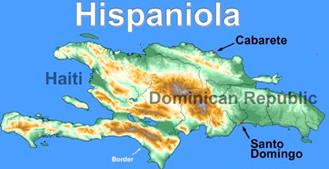 The Taino/Arawak (Amerindians) were living on Hispaniola in relative peace for centuries, with the only occasional threat coming from the warlike Caribs who began moving up the Lesser Antilles in the 1100s raiding Taíno villages on the island's eastern coast, by the time Christopher Columbus stumbled across Hispaniola in December 1492.
The Taino/Arawak (Amerindians) were living on Hispaniola in relative peace for centuries, with the only occasional threat coming from the warlike Caribs who began moving up the Lesser Antilles in the 1100s raiding Taíno villages on the island's eastern coast, by the time Christopher Columbus stumbled across Hispaniola in December 1492.
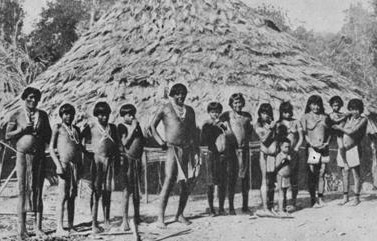 The Taino/Arawaks befriended the Spanish and presented them with gifts of gold jewellery. The Spanish assumed that Hispaniola was a gold mine and this led to many voyages to the island in search of this imaginary gold.
The Taino/Arawaks befriended the Spanish and presented them with gifts of gold jewellery. The Spanish assumed that Hispaniola was a gold mine and this led to many voyages to the island in search of this imaginary gold.
An estimated 400,000 Tainos living on the island were enslaved by the Spanish Settlers and forced to work in the gold mines, killing those who dissented, but after no gold was found, the colonists transformed the island into a bread basket to feed the conquistadors who were exploring and conquering the native people in the rest of the Caribbean and Central America.
Hispaniola was an island of fine rain forests and fertile plains that required thousands of slaves to work the sugar plantations and other farming industries. It is estimated that by 1508 the number of Tainos had dwindled to about 50,000 as a result of oppression, forced labour, hunger, mass killings, and disease brought in by the Spanish, so that within 25 years of Columbus’ initial voyage, the indigenous Amerindian population was practically wiped out.
In 1501, the Spanish monarchs Ferdinand I and Isabella granted permission to the colonists to import African slaves to replace the Taino/Arawak, who immediately became the main source of labour. The slave trade was so profitable that by 1672 The Royal Afrikan Company chartered by Charles II of England, surpassed the other traders and became the richest transporters of human slaves to the mainland of the Americas. The slaves were so valuable to the open market that they were referred to as Black Gold. However, Hispaniola soon became an island of little interest to the Spanish, so they began to establish other settlements in different locations throughout the Caribbean, Central and South America.
Toward the end of the European war at the Treaty of Ryswick in 1697, the Spanish surrendered the western portion of Hispaniola to the French crown, thereby dividing the island into two separate states. The eastern Spanish portion was called Santo Domingo, and the western French portion was called San Domingue, (St. Dominique). Hispaniola, with Haiti located on the western 1/3 of the island, was populated primarily by Afrikan-Caribbean people with a history of French colonialism, while the Dominican Republic (Santo Domingo) located on the eastern 2/3 of the island, was populated by Afro-European mixed blooded people with roots heavily influenced by Spanish colonialism.
When the French grasped control, they instituted an exceptionally inhuman form of slavery worse than in any other region in the Western world. The French colonial slave system was intensely brutal, with the slaves being flogged, starved, and even buried alive for minor offences.
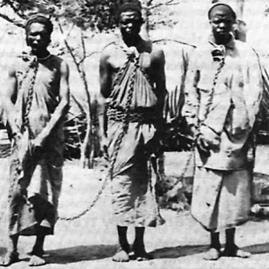 In the 17th and 18th centuries, Spain and France built Haiti’s population by kidnapping and enslaving hundreds of thousands of Afrikans. The new colony, San Domingue, through the heavy importation of Afrikan slaves and massive environmental degradation, rapidly became the wealthiest colony in the Caribbean, with its capital, Cap Français, known as the Paris of the New World. Haiti became the richest French colony in the entire Americas, including the mineral rich Mexico and Peru, mainly because of the great agricultural riches in addition to literally working their slaves to death as a result of the extremely harsh working conditions. By 1789, 29,000 African slaves were arriving in San Domingue every year, which meant unspeakable horror for the slaves, as one third died within three years of their arrival, but it meant enormous wealth for France. Haiti, once known as the Jewel of the Antilles, had developed an agricultural economy based on slave labour which produced sugar cane, coffee, cotton, tobacco, many exotic spices and the dye indigo, which were all in high demand throughout Europe and Asia. This achievement was made possible by the labour and knowledge of thousands of enslaved Africans who brought their technology and expertise to the island.
In the 17th and 18th centuries, Spain and France built Haiti’s population by kidnapping and enslaving hundreds of thousands of Afrikans. The new colony, San Domingue, through the heavy importation of Afrikan slaves and massive environmental degradation, rapidly became the wealthiest colony in the Caribbean, with its capital, Cap Français, known as the Paris of the New World. Haiti became the richest French colony in the entire Americas, including the mineral rich Mexico and Peru, mainly because of the great agricultural riches in addition to literally working their slaves to death as a result of the extremely harsh working conditions. By 1789, 29,000 African slaves were arriving in San Domingue every year, which meant unspeakable horror for the slaves, as one third died within three years of their arrival, but it meant enormous wealth for France. Haiti, once known as the Jewel of the Antilles, had developed an agricultural economy based on slave labour which produced sugar cane, coffee, cotton, tobacco, many exotic spices and the dye indigo, which were all in high demand throughout Europe and Asia. This achievement was made possible by the labour and knowledge of thousands of enslaved Africans who brought their technology and expertise to the island.
The planters produced the goods but were forbidden from processing them, so all the products were shipped to France for processing before being refined, packaged, and sold in Europe and Asia, thus creating a booming economy for France. Haiti's slave system was the most brutal in the Caribbean, and ensured that the slaves worked long days under tremendously unsafe conditions with little or no tools beyond hand labour.
Many documents of Western slavery publicly stated that the ultimate threat to a rebellious slave was that he or she would be sold to Haiti. However, the French allowed the number of slaves to grow without any control until it reached a 10-1 ratio of free to slave population within 100 years of colonial rule. By 1791 there were approximately 500,000 slaves and about 50,000 free people. About 30,000 of those free people were of colour, both black and mulatto. In the French colonial system, freed people of colour could own slaves and property.
Unfortunately for the masses of Haitians, the key model of forced cheap labour was passed on to the emerging native Haitian elite. The French system allowed for some slaves to earn their freedom through outstanding work that guaranteed greater productivity from the slaves, but the system was so tough that very few slaves were actually able to obtain their freedom. Slave owners therefore got increased productivity but with hardly any loss of slaves through freedom.
A second group of slaves that became free were the mulattos, the children of white masters and slave women. These children were embarrassing to both slaves and whites. The slaves never knew how the white man would respond to his child, and often the slave owner did not want to be reminded of his paternity, so the mulattos were not welcomed in either community. The freed mulattos therefore formed a special middle class in the colonial period. They were able to receive the best education, operate businesses, own property and in general imitate the French which became the hallmark of these freed people, as they wanted to be clearly distanced from their slave backgrounds. They adopted the French language, culture, religion, dress, and education, but most importantly, they learnt the value of slave labour, ensuring that the colonial French heritage continued in the elite's imitation of the French labour system.
For 182 years the Haitian rulers used terror, illegal arrests, detentions, beatings, killings, forced exile, and other similar measures to keep the masses under control. Corruption was practiced beyond measure in Haiti. The elites used their positions in government to acquire the wealth and power of Haiti for themselves. In other words, what little wealth the country had was channelled into the hands of this elite group. Foreign governments, humanitarian and religious organizations have attempted to aid the suffering people of Haiti on many occasions, but throughout the 182 years of freedom, the Haitian elite and government officials had diverted much of this wealth into their own pockets.
The brutality of the French slave system and the huge number of slaves in relation to the freed people set the stage for a lasting revolution. Enslavement of the Afrikans continued until events took an unusual turn.
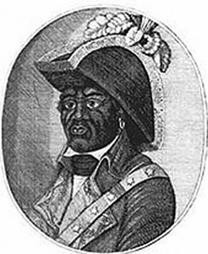 In August of 1791, about 500,000 slaves instigated by Dutty Boukman, a voodoo priest, rose up against their French and mulatto masters, signalling the first major Black rebellion which forced France to abolish slavery by 1794. This also marked the beginning of the end of one of the greatest wealth-producing slave colonies the world had ever known. The uprising developed into a full-scale civil war between the Black dominated north and the mulatto dominated south. Many former and escaped slaves known as Maroons joined in the revolt. Boukman conducted a ceremony at the Bois Caïman where he prophesied that Jean François, Georges Biassou, and Jeannot (Bullet) would be leaders of a slave revolt that would liberate the slaves of Haiti. However, soon after the revolt began, Boukman was captured and beheaded by French authorities who displayed his head publicly, in an attempt to crush the feeling of invincibility that Boukman had inspired, but this tactic failed.
In August of 1791, about 500,000 slaves instigated by Dutty Boukman, a voodoo priest, rose up against their French and mulatto masters, signalling the first major Black rebellion which forced France to abolish slavery by 1794. This also marked the beginning of the end of one of the greatest wealth-producing slave colonies the world had ever known. The uprising developed into a full-scale civil war between the Black dominated north and the mulatto dominated south. Many former and escaped slaves known as Maroons joined in the revolt. Boukman conducted a ceremony at the Bois Caïman where he prophesied that Jean François, Georges Biassou, and Jeannot (Bullet) would be leaders of a slave revolt that would liberate the slaves of Haiti. However, soon after the revolt began, Boukman was captured and beheaded by French authorities who displayed his head publicly, in an attempt to crush the feeling of invincibility that Boukman had inspired, but this tactic failed.
 In 1796 Toussaint L'Ouverture who was a former slave, an educated herbal doctor and military officer, emerged as leader of the former slaves in the north. Toussaint rose in rank as a military commander because of his various skills which he utilized to restore order, end the massacres, and bring back some of San Domingue's former glory after years of war against external invaders and internal dissension. After establishing a well disciplined and flexible army, Toussaint drove out the Spaniards and the British invaders who posed a threat to the colony.
In 1796 Toussaint L'Ouverture who was a former slave, an educated herbal doctor and military officer, emerged as leader of the former slaves in the north. Toussaint rose in rank as a military commander because of his various skills which he utilized to restore order, end the massacres, and bring back some of San Domingue's former glory after years of war against external invaders and internal dissension. After establishing a well disciplined and flexible army, Toussaint drove out the Spaniards and the British invaders who posed a threat to the colony.
Accounts of his military triumphs were circulated worldwide which embarrassed and disgraced the European armed forces. Toussaint’s triumphs then permitted him to become governor, where he drew up a constitution and proclaimed himself as the permanent leader. He also announced that slavery would not be practiced in San-Domingue again.
 In the meantime Napoleon Bonaparte ascended to a powerful position in France and did not like Toussaint’s constitution, so he made plans to permanently put an end to the new Black Republic. Therefore he assembled the biggest fleet of ships in the history of France and set sail to
San-Domingue where he launched an unexpected attack that proved to be too much for the Black Republic, causing Toussaint L’ouverture to surrender on May 6th 1802.
In the meantime Napoleon Bonaparte ascended to a powerful position in France and did not like Toussaint’s constitution, so he made plans to permanently put an end to the new Black Republic. Therefore he assembled the biggest fleet of ships in the history of France and set sail to
San-Domingue where he launched an unexpected attack that proved to be too much for the Black Republic, causing Toussaint L’ouverture to surrender on May 6th 1802.
Napoleon Bonaparte recognised the vital economic importance of the colony and made every attempt to defend its rule since he could not imagine the republic without slavery, so he targeted the Haitians for a new, more intense system of slavery to which the British agreed, as did the Dutch, Spanish and Portuguese.
Napoleon stated, “My decision to destroy the authority of the Blacks in Saint Domingue is not so much based on considerations of commerce and money, as on the need to block forever the march of the Blacks in the world.”
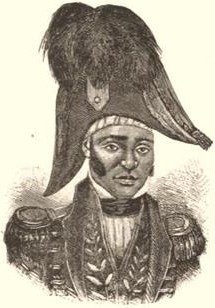 Napoleon had dispatched a strong military army of about 34,000 troops to Haiti in an attempt to subdue the slave armies and win back the colony for France, but this only ignited the Haitian revolutionary spirit. The nation was shocked and terrified by this French invasion, so they began to attack and killed any French nationals on the island. Toussaint was captured but Jean Jacques Dessalines, another former slave with an army of self-emancipated slaves, persevered until they defeated and ousted Napoleon's army that was sent to restore slavery, finally winning the 10 year war that was described as the bloodiest in modern history.
Napoleon had dispatched a strong military army of about 34,000 troops to Haiti in an attempt to subdue the slave armies and win back the colony for France, but this only ignited the Haitian revolutionary spirit. The nation was shocked and terrified by this French invasion, so they began to attack and killed any French nationals on the island. Toussaint was captured but Jean Jacques Dessalines, another former slave with an army of self-emancipated slaves, persevered until they defeated and ousted Napoleon's army that was sent to restore slavery, finally winning the 10 year war that was described as the bloodiest in modern history.
In total, France lost over 50,000 soldiers including 18 generals in its attempt to retake the colony, and following their defeat by the Haitians, the French were forced to cede Louisiana to the U.S.A. on April 30th 1803.
San-Domingue became the world’s first Black Republic in 1803, but Toussaint L’ouverture, who was locked up in a jail cell in France had perished and did not get to witness the triumph of his people. But it was because of him that the slaves continued to fight in the first place, and his devotion and eagerness to be liberated symbolized all of the suppressed slaves who battled for liberty and civil rights.
After Haiti gained its freedom, independence was declared on January 1st, 1804, with Haiti becoming the only nation in world history that was born out of a successful slave revolt. On January 1st, 1804, San-Domingue ceased to exist and modern Haiti was born.
Jean Jacques Dessalines proclaimed the first independent Black Republic of Haiti, - the first in the Western Hemisphere, - and his men declared him emperor, while naming the island after its Amerindian name, Ayiti, which means "land of mountains". It was a glorious moment in the history of Haiti. For the first time since slavery had begun, Blacks were the subjects of mass freedom and citizenship in a nation. Haiti proceeded to place in its 1805 Independence Constitution that any person of African descent who arrived on its shores would be declared free and a citizen of the Republic.
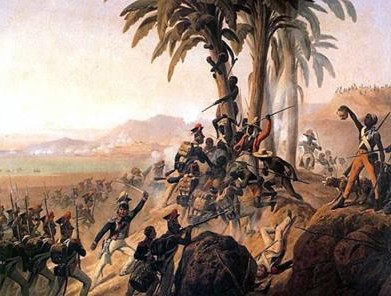 After the revolution ended in January 1804, Haiti became the second free country in the Western World after the U.S.A, but the U.S.A was still a slave nation as was England. While France had freed Haitian slaves during the revolution, France and other European nations still had slaves in Africa and Asia, so the Western World, after seeing the Haitian slaves rise up and gain independence began to panic, fearing that it would spread, so they decided to get even.
After the revolution ended in January 1804, Haiti became the second free country in the Western World after the U.S.A, but the U.S.A was still a slave nation as was England. While France had freed Haitian slaves during the revolution, France and other European nations still had slaves in Africa and Asia, so the Western World, after seeing the Haitian slaves rise up and gain independence began to panic, fearing that it would spread, so they decided to get even.
The white slave owning world was utterly shocked by the victory of the Haitian revolutionaries over the powerful French army. There was much discussion of "servile revolutions" and the fear that slaves in other places would use the successful Haitian revolt as a model and start rebelling also. This caused particular fear in the south of the United States where agriculture, cotton and tobacco were completely dependent on the slave market.
After the French left, there was a scramble for power and control in Haiti. The elites emerged as the dominant power because of their superior education and experience in running businesses and other affairs. But a pattern also developed since the only model known for successful agriculture was the engraved slave system. It would have been difficult to return the masses to slavery, but Jean-Jacques Dessalines tried to enforce a system of labour on the peasants by binding them to particular plantations owned by the elite, but this system failed, and in the process it created a labour system which was partly responsible for the early suffering of Haiti.
Although an independent government was created in 1804, Haitian society continued to be deeply affected by the patterns established under French colonial rule. The post-rebellion racial elite continued the legacy of oppressive rule with military coups that placed a total blight on Haiti ever since.
Jean-Jacques Dessalines forbade white people from owning property, and decreed that the black population must either work on the plantations or in the army. He was unpopular with the mulattos and in 1806 he was assassinated. Haiti was predominately a black republic with a constitutional prohibition against white people owning land. This particular provision of the Haitian constitution lasted until 1918 when the U.S.A. invaded Haiti and imposed a constitution that did not contain this prohibition.
The French refused to recognise Haiti's independence and declared it an illegal pariah state. The Americans, whom the Haitians looked to in solidarity as their mentor in independence, also refused to recognize them while offering solidarity to the French instead. The British, who were negotiating with the French to obtain the ownership title to Haiti also moved in solidarity with France, as did every other nation state in the Western world. Victory therefore came at a tremendous cost to Haiti, since most countries were still capturing slaves. England did not fully banish slavery until 1833, the first major white nation to do so, while the U.S.A. continued to hold slaves until 1862. Since the U.S.A. still condoned slavery, it meant that Haitian freedom could not be recognized, therefore Haiti was isolated from partnership in world affairs. They believed that a slave rebellion was not the ideal situation to have so close to a nation that already owned millions of slaves, therefore the international community argued that a nation born of a slave revolt, set too dangerous a precedent in a world heavily dependent on slave labour. It was therefore easy for France to persuade Spain and the U.S.A. to join in the economic embargo against Haiti. As a result, Haiti was cut off from any trade and development by this total blockade that lasted throughout most of the 19th century. This international conspiracy to boycott Haitian goods and commerce plunged the Haitian economy into chaos that was devastating for Haiti's long-term economic development.
The white nations of Europe and the U.S.A. therefore were unanimous in their decision not to recognize Haiti’s independence, and even boycotted trade relations with Haiti. Further, there was a great outcry in the white world that black people were inherently incapable of ruling themselves, so multitudes of books and pamphlets overstressed this myth in the early 19th century, and Haiti regularly came in for attack as one of the main pieces of proof of this failure.
As Haitians were discriminated against by the U.S.A. and all the European nations, funds were not available to educate the Haitian people, nor did any significant trade exist with any country outside of Haiti. Therefore Haiti was isolated, blacklisted and denied access to world trade, finance, and institutional development from the inception. It was the most vicious example of national strangulation recorded in modern history. As a result of that isolation, Haiti never got the chance to progress alongside the surrounding civilizations in the region.
Imperial propaganda originating from Western Europe and the United States showed that Haiti's independence was defeated by this aggressive North-Atlantic alliance which could not imagine their world being inhabited by a free regime of Afrikans as representatives of a newly emerging democracy. The price that the Haitian masses paid for their freedom was to live below subsistence and remain in tiny huts on non-fertile mountain regions in order to have peace and freedom from oppression.
France also refused to let her rights to the land and its inhabitants go uncompensated so they stationed warships off Haiti’s coast. The Haitian government was desperate to be recognized by France and the Europeans, and wanted to find a way to be welcomed back into the world economy. The French government was invited to a summit where officials came and informed the Haitian government that they were willing to recognise the country as a sovereign state, but it would have to pay compensation and reparation in exchange for the lands which the former slave owners had acquired after the revolution.
The French government sent a team of accountants and auditors to Haiti to evaluate all the lands, all physical assets, the 500 000 citizens who were former slaves, animals, and all other commercial properties and services. Even members of the Cabinet were evaluated seeing that they were slaves before independence. The final figure calculated amounted to 150 million gold francs which Haiti was told to pay to France in order to receive national recognition. With their backs against the wall, and having endured 25 long years of international isolation and threats supported by the U.S.A. and Europe, President Jean-Pierre Boyer of Haiti agreed to take out a loan from a designated French bank in 1838, to pay those reparations to France, to compensate the former slave owners and their heirs for loss of “property.” This pushed Haiti into a massive state of indebtedness, seeing that the debt total, which has a current value of over 21 billion dollars, was ten times that of Haiti’s total 1825 revenue, and double the cost of the Louisiana Purchase paid by the United States to France for 74 times more land. This was how the systematic destruction of the Black Republic of Haiti started.
The imposition of this compensation by a defeated power and reimbursement by freed slaves to their former owners is unique in history and also violated international law. The 1825 agreement began a cycle of debt that had condemned the Haitian people to poverty ever since. This debt plagued Haiti’s economy and kept it in debt to France for the next 80 years. The debt to France was finally repaid in 1879, but Haiti did not finish paying the loans that financed the debt until 1947. During that time, Haiti paid several times over the 150 million francs in interest on the debt, and in the years when the coffee crops failed or the sugar yield was down, the Haitian government borrowed funds on the French money market at double the going interest rate in order to repay the French government.
The French government therefore bled the Haitian nation and rendered it a failed state. It was a merciless exploitation that was designed and guaranteed to collapse the Haitian economy and society. Over a century after the global slave trade was recognized and terminated as the evil it was, Haitians were still paying their ancestors’ masters for their freedom. There are about 10 million people in Haiti who share the collective debt of about 900 million dollars. France became rich and took pleasure from the fact that although they were defeated by the Haitian slaves on the battlefield, they had defeated the Haitians on the financial field. The destruction of the Haitian nation resides at the feet of France and America, two of the most powerful nations on earth, which betrayed, failed, and destroyed Haiti’s dream of freedom and justice.
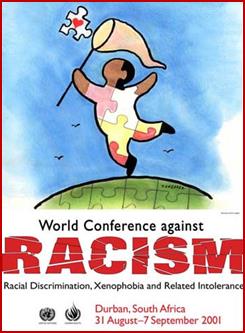 During the 2001 UN Conference on Race in Durban, South Africa, a strong representation was made to the French government to repay the 150 million francs, estimated by financial auditors to be US$21 billion that were illegally extorted from the Haitian people and should therefore be repaid so it could assist in the rebuilding of Haiti and place it in a position to re-engage the modern world.
During the 2001 UN Conference on Race in Durban, South Africa, a strong representation was made to the French government to repay the 150 million francs, estimated by financial auditors to be US$21 billion that were illegally extorted from the Haitian people and should therefore be repaid so it could assist in the rebuilding of Haiti and place it in a position to re-engage the modern world.
In the 1900s, peasant uprisings led to United States fears over Caribbean instability, and in responding to complaints to President Woodrow Wilson from American banks to which Haiti was deeply in debt, American Marines invaded Haiti using a trumped up excuse that they were assisting the French in collecting its reparations. Some reports indicated that as many as 10,000 political leaders and organizers (referred to as rebels) were killed by American troops during the initial stages of this invasion and occupation.
The United States was mainly uneasy about the unequal amount of economic power the German community was wielding in Haiti, since the Germans controlled about 80% of the country's international commerce; owned and operated utilities in Cap Haïtien and Port-au-Prince which is the main wharf and a tramway in the capital, as well as a railroad serving the Plaine de Cul-du-Sac. They also served as the principal financiers of the nation's many revolutions, floating countless loans at high interest rates to competing political factions. Moreover, the German community was more willing to marry into Haitian society than any other group of white foreigners including the French. A number of Germans had married into the nation's most prominent mulatto families to bypass the constitutional prohibition against foreign land ownership.
So in an effort to restrict German influence, the U.S.A. State Department in 1910-11 supported a consortium of American investors assembled by the National City Bank of New York, to acquire control of the nation's only commercial bank and the government treasury. The Americans assumed control over the banks, the collection of revenues, and also imposed a new Haitian constitution which repealed the 1804 provision that foreigners could not own land in Haiti. The U.S.A. then decided who could and could not be government servants. The only factor of Haitian life that escaped American domination was education, since the elite's identification with the French culture was too strong for even the marines to overcome. The schools therefore remained French in language and structure.
The most serious blow Haiti ever had to her independence and self-image was this occupation by the United States Marines in 1915 which lasted for 19 years, because it put down any Haitian attempts to reclaim their independence and become a self-sustaining country. Ever since the occupation, the United States, through the power of its aid packages, have played a pivotal role in Haitian politics, and have been contributing to the misery of Haiti by imposing oppressive governments with comfortable aid packages to keep them in power. The United States may not have been interested in furthering Haitian poverty itself, but it was the price paid to keep friendly governments in power so that the American military, propaganda and economic interests could be served.
 A former Minister of Health and union leader who earned the reputation as a humanitarian while serving as an administrator in an American funded campaign, François Duvalier also known as Papa Doc, soon established another dictatorship and made himself president for life in 1957. His regime was seen as the most repressive and corrupt in modern times, combining violence against political opponents while setting himself up as a Vodou priest to consolidate his power over the poor Black majority with the rebirth of Haiti's Vodou traditions.
A former Minister of Health and union leader who earned the reputation as a humanitarian while serving as an administrator in an American funded campaign, François Duvalier also known as Papa Doc, soon established another dictatorship and made himself president for life in 1957. His regime was seen as the most repressive and corrupt in modern times, combining violence against political opponents while setting himself up as a Vodou priest to consolidate his power over the poor Black majority with the rebirth of Haiti's Vodou traditions.
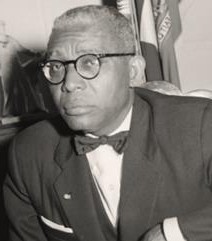 François Duvalier terrorized the country by rooting out any and all opponents to his administration, and was widely credited with the deaths of 30,000 Haitians mostly at the hands of the Tonton Macoutes which was a private paramilitary force created by him to replace the disbanded army which he feared might topple him. Many Vodou priests were absorbed into the ranks of the Macoutes and received land confiscated from the peasants. Duvalier’s public acceptance of Vodou with his private devotion to Vodou rituals combined with his knowledge of magic and sorcery, helped to embellish his popular charisma among the common people, and served to inject terror into the population. However, despite the religious nature of Vodou, these ruthless murderers killed more than 60,000 Haitians, and forced hundreds more to abandon their homes.
François Duvalier terrorized the country by rooting out any and all opponents to his administration, and was widely credited with the deaths of 30,000 Haitians mostly at the hands of the Tonton Macoutes which was a private paramilitary force created by him to replace the disbanded army which he feared might topple him. Many Vodou priests were absorbed into the ranks of the Macoutes and received land confiscated from the peasants. Duvalier’s public acceptance of Vodou with his private devotion to Vodou rituals combined with his knowledge of magic and sorcery, helped to embellish his popular charisma among the common people, and served to inject terror into the population. However, despite the religious nature of Vodou, these ruthless murderers killed more than 60,000 Haitians, and forced hundreds more to abandon their homes.
Duvalier's policies which were designed to end the dominance of the mulatto elite over the nation's economic and political life caused Haiti to endure an incomparable and paralyzing brain drain that stripped Haiti of many of its most skilled and highly trained civilians, thus deepening Haiti's economic and social problems. However, Duvalier captivated the Black middle class by introducing public works into their neighbourhoods which previously had no paved roads, running water, and modern sewage systems.
When the American occupation of Haiti ended in 1934, it left a gap of immense political unrest and poverty for Haitians. The U.S.A., France and Canada supported dictators like Francois Duvalier, who murdered and terrorized his own people, killing tens of thousands of political opponents. Duvalier was supported because there were fears that Cuba might spread communism to the rest of the Caribbean and Haiti might become a communist nation because of its close strategic proximity to Cuba.
 Francois Duvalier died in 1971 and his son Jean-Claude Duvalier also known as Baby Doc, succeeded him at age 19, also making himself president for life. He was even more ruthless than his father, continuing the same repressive policies, but soon began to lose the support of the black majority. When Jean-Claude Duvalier got married to a mulatto divorcee, Michèle Bennett in a $3 million ceremony in 1980, it provoked widespread opposition as it was seen as a betrayal of his father's hatred towards the mulatto elite.
Francois Duvalier died in 1971 and his son Jean-Claude Duvalier also known as Baby Doc, succeeded him at age 19, also making himself president for life. He was even more ruthless than his father, continuing the same repressive policies, but soon began to lose the support of the black majority. When Jean-Claude Duvalier got married to a mulatto divorcee, Michèle Bennett in a $3 million ceremony in 1980, it provoked widespread opposition as it was seen as a betrayal of his father's hatred towards the mulatto elite.
 Jean-Claude Duvalier, his ex-wife Michèle Bennett Duvalier, along with others acting as agents, are believed to have embezzled around $540 million from the Haitian public treasury between 1971 and 1986, most of which came from relief money donated to Haiti by international aid organizations and foreign governments. The Duvaliers used these funds to finance their personal lavish life style which included a $1million yacht, a luxurious villa in France, and widely-publicized shopping trips to Miami and New York, while extreme poverty continued to strangle Haiti. By this time Haiti had become the poorest nation in the western hemisphere.
Jean-Claude Duvalier, his ex-wife Michèle Bennett Duvalier, along with others acting as agents, are believed to have embezzled around $540 million from the Haitian public treasury between 1971 and 1986, most of which came from relief money donated to Haiti by international aid organizations and foreign governments. The Duvaliers used these funds to finance their personal lavish life style which included a $1million yacht, a luxurious villa in France, and widely-publicized shopping trips to Miami and New York, while extreme poverty continued to strangle Haiti. By this time Haiti had become the poorest nation in the western hemisphere.
Between 1957 and 1986, Haiti was ruled by American backed Papa Doc Duvalier and his son Baby Doc who for thirty years diverted foreign assistance for their own private interests that accounted for over half of Haiti’s current debt to foreign lenders. The corruption and repression of these regimes that stole aid money earmarked for the very poor, forced the educated professionals into exile and created a serious brain drain from which Haiti has never recovered. This led to a severe lack of teachers and doctors. A nation without any industrial skills that was not allowed to trade its products with the rest of the world would obviously fail to attract industries that would help to improve its situation.
 In addition to this, the rapid deforestation of Haiti got under way during the colonial period, later escalating in 1730 when coffee production was introduced and the continued plowing to prevent the spread of bush depleted soil nutrients which led to accelerated erosion. But another major reason for this state of destruction was as a result of the Haitian peasants using farming methods that were harmful to the land such as burning off top soil, but since the only fuel in the country was wood, the vast forests of Haiti were chopped down little by little for charcoal. This demand for charcoal has doubled over the last 20 years, hence increasing the rate of deforestation while exposing the mountainside to irreversible soil erosion and the country to serious flooding during the rainy season. Economic destruction also followed from decades of French rule after the French stripped Haiti of its mahogany forests and grabbed much of its natural resources.
In addition to this, the rapid deforestation of Haiti got under way during the colonial period, later escalating in 1730 when coffee production was introduced and the continued plowing to prevent the spread of bush depleted soil nutrients which led to accelerated erosion. But another major reason for this state of destruction was as a result of the Haitian peasants using farming methods that were harmful to the land such as burning off top soil, but since the only fuel in the country was wood, the vast forests of Haiti were chopped down little by little for charcoal. This demand for charcoal has doubled over the last 20 years, hence increasing the rate of deforestation while exposing the mountainside to irreversible soil erosion and the country to serious flooding during the rainy season. Economic destruction also followed from decades of French rule after the French stripped Haiti of its mahogany forests and grabbed much of its natural resources.
Furthermore, another reason for Haiti's poverty and misery was making the French language compulsory on Haitians. French became the official language of the country, but this was a foreign tongue to the masses of Haitians. All state business was conducted in French, and the schools taught mainly in French. Social prestige was then related to the ability to speak French, yet only about 10% of the people could converse moderately in French with less than 5% knowing the language fluently.
Kreyol (Creole) is the language of the Haitian people, and 100% of Haitians speak and understand kreyol as their mother tongue. Kreyol is not a patois or dialect of French, but a recognized language in its own right with its own syntax which is considerably different from the French language. The kreyol grammar is rooted in the Central African languages, though most of its vocabulary is currently influenced by French. Kreyol is the fusion of two dissimilar languages resulting in a new language being formed out of necessity for two parties to be able to communicate with each other. The French colonialist occupied Haiti in 1629 and needed Afrikan slaves to work the plantations, but since neither spoke the others' language, the necessity to devise a common line of communication evolved into what is known as Haitian Kreyol (Creole).
The basic lexical structure of Haitian Creole is 18th century French in origin, but the sentence structure (syntax) and influences came from the West African languages like Wolof, Fon, Mandingo and Ewe, which were spoken by the vast majority of slaves brought to Haiti from the former kingdom of Dahomey (Benin). Other contributions also came from Taíno, Spanish, Arabic and much later, English. It is therefore important to note that French and Haitian Creole are two distinct languages and not variations of the same language.
Although French became the official language at the end of the revolution in 1804, many Haitians do not speak French. More importantly was the brainwashing that French is only the language of well-educated and intelligent people, as this has caused peasants who only speak kreyol to scorn their own language, and also demand that their children be educated in French, which guaranteed that their children would not succeed in school.
Fluency in French has served as an indicator of social class ever since colonial times, and since only whites and educated mulatto freedmen spoke French during those times, knowledge of French became the distinguishing trait between those who were free before the Revolution, and those who had only recently acquired freedom. The road to social, economic and intellectual development was therefore reserved to the French speakers while the masses were kept in their misery because their language was not recognized nor allowed to become an official language.
 The school system did very little to help Haiti out of her massive ignorance and illiteracy; if anything, it helped to continue the reliance on French which was one of the major controlling tools of the Haitian state. One of the results of this oppression of language is a national illiteracy rate of 90% in the cities, and even higher in rural areas. It is hard to calculate the suffering tied to illiteracy since when a whole people cannot read, they become cut off from advances in knowledge. Although education is supposed to be free and open to all, state-sponsored education is limited, and most secondary and university education go to the children of the elite. Only about 30% of Haitian children start school, of which only 2% remain in school beyond the 5th grade.
The school system did very little to help Haiti out of her massive ignorance and illiteracy; if anything, it helped to continue the reliance on French which was one of the major controlling tools of the Haitian state. One of the results of this oppression of language is a national illiteracy rate of 90% in the cities, and even higher in rural areas. It is hard to calculate the suffering tied to illiteracy since when a whole people cannot read, they become cut off from advances in knowledge. Although education is supposed to be free and open to all, state-sponsored education is limited, and most secondary and university education go to the children of the elite. Only about 30% of Haitian children start school, of which only 2% remain in school beyond the 5th grade.
Most Haitians live on $1 per day, and those working in the garment industry are paid about $2 per day. The national minimum wage was about $2.60 per day, yet many companies get around even this meagre wage by shifting their pay system to piece work so that the typical wage is closer to $2.00 which is under the minimum wage level. The $2.00 a day wage is almost double the $1.00 typically earned in the agricultural sector, however, the American firms who own and run these plants earn ridiculously excessive rates of return on their capital, with profits generated entirely by the sweat of the poor Black Haitian people. Cane cutters spend an entire day in back-breaking conditions to cut a ton of sugar cane just to earn $1.00.
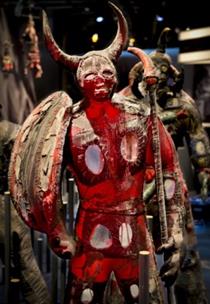 Haiti has therefore been cursed with grueling poverty, low literacy rates, and occasional natural disasters, but clearly this poverty and misery in Haiti were created by humans.
Haiti has therefore been cursed with grueling poverty, low literacy rates, and occasional natural disasters, but clearly this poverty and misery in Haiti were created by humans.
Therefore, the argument that the Vodou religion was a serious factor in causing the misery of Haiti is a myth. The root causes were the political and economic systems which have dominated Haiti throughout her 182 years. These oppressive factors originated from the international community, especially France and the United States, along with the Haitian elite which comprises of a mere 3% of the Haitian people, were all contributing factors that caused and sustained these oppressive conditions.

© John Moore - Barbados, W.I. (March 2000) ©. All rights reserved.